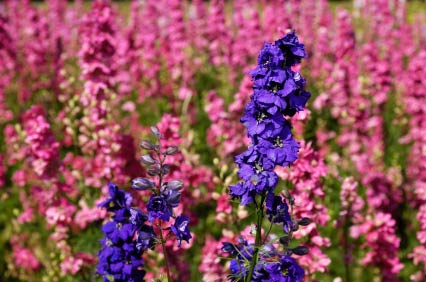Larkspur, can refer to any one of 300 species of perennial
flowering plants in the delphinium family, as well as to their close
cousins in the consolida family. Its genus name, delphinium, comes
from the Greek word for dolphin, because the plant was said to
resemble a dolphin’s nose. Other popular names include lark’s
heel, lark’s claw and knight’s spur.
The flowers grow in groups along a single stalk, much like
gladioli, and range in color from whites and yellows to deep reds,
blues, and purples. Each flower has five petals and a protruding
center – its “spur.”
Larkspur is poisonous if ingested, and is responsible for many
cattle deaths in areas where it grows wild in pastures. This flower
has significance in Greek mythology as it grew from the blood of Ajax
as he threw himself on his sword during the Battle of Troy. Native
Americans used Larkspurs to make a rich, blue dye. European settlers
used it to dip their quills in as blue ink. It is also said to have
medicinal and magical properties, and has been used to cure eye
diseases, asthma, dropsy, and head lice. It was also believed to
provide protection against lightning, and, in Transylvania, it was
planted around stables, allegedly to to keep witches away.

No comments:
Post a Comment
I moderate comments only to keep fools from gumming up my pages with repetitive idiotic spam.
Note: Only a member of this blog may post a comment.